After this trip, I have visited 81 countries in the World!!
Amsterdam: Wed. May 3 through Fri. May 5, 2023
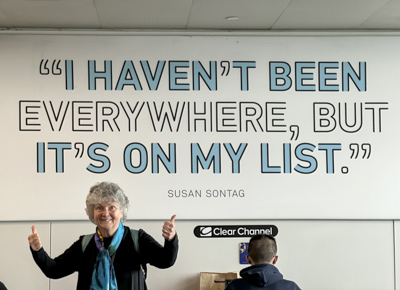
Jeff and I took an overnight flight from New York City and arrived in Amsterdam on Wednesday, May 3rd at 5:30 in the morning! The taxi from Schiphol Airport breezed through empty streets to the center of the city and the hotel we had booked online: the NH Collection Flower Market Hotel.

We were in Amsterdam for three days before starting a Baltic Sea Cruise on Saturday. We arrived a few days early to give our bodies a chance to adjust to a different time zone. We were tired from lack of sleep on the plane, so on our first day, we took a leisurely canal-boat tour.
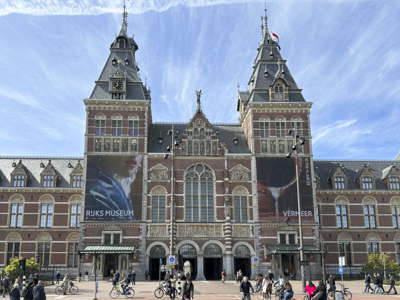
Amsterdam is a delightful city with interesting architecture and many beautiful canals and bridges. We were eager to try Dutch cuisine so we searched for restaurants that served traditional “stamppot,” “bitterballens,” “poffertjes,” “stroopwafels,” “vlaamse frieten,” and “erwtensoep/snert.” And, of course, Jeff found De Kaaskamer van Amsterdam – an amazing cheese shop located in the 9 Streets district.

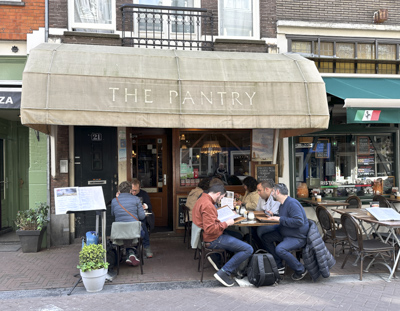

On our second day, we visited the Van Gogh Museum. We had pre-booked timed tickets which we purchased at home. This worked out well because all tickets for the week were sold out. The museum had expanded since our last visit to Amsterdam with a modern two-story glass entrance.
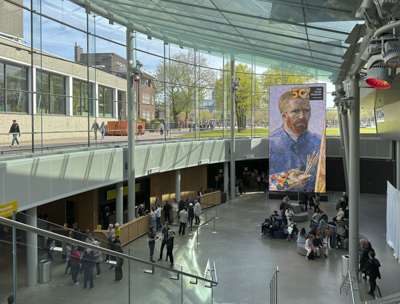
The weather was glorious – clear 50 to 65 degrees – perfect for walking around the city and taking pictures. We visited Rembrandt’s House Museum and walked around several interesting neighborhoods.
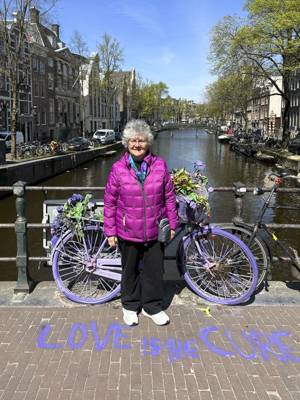
We had read that there are more than 840,000 bicycles in Amsterdam. That’s more bicycles than residents! Many bicycles were decorated with colorful artificial flowers celebrating spring.

On Saturday, May 6th we boarded Holland America’s MS Rotterdam: our home-away-from-home for a 14-Day Cruise around the Baltic Sea to visit several northern capital cities: Copenhagen, Stockholm, etc.

The Rotterdam was launched in 2021 and is the newest ship in the Holland America fleet. It holds about 2,600 passengers and 1,000 crew members.
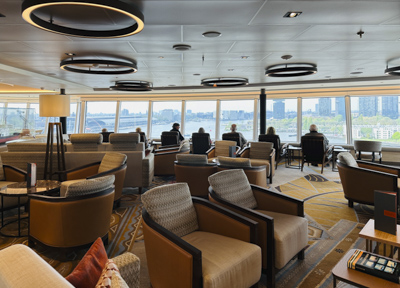
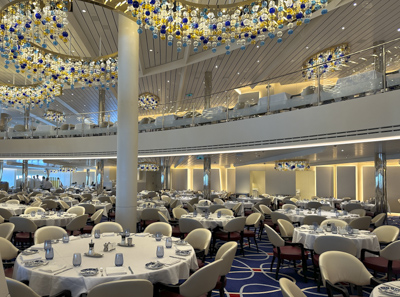
The main pool area in the photos below had a retractable roof and was used as a multi-purpose area. The roof opened on warm days and during evening hours it became a social gathering place. At night, lounge chairs were set up with blankets so passengers could watch first-run movies under the stars. Popcorn was included!
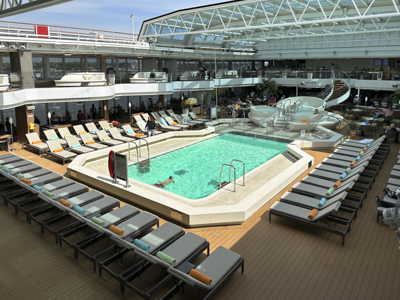

The World Stage theater was located on Decks 2 and 3, all the way forward in the bow of the ship. It had 714 seats and was almost a theater-in-the-round. The multi-level Atrium was located in the center of the Rotterdam and connected restaurants and shops.
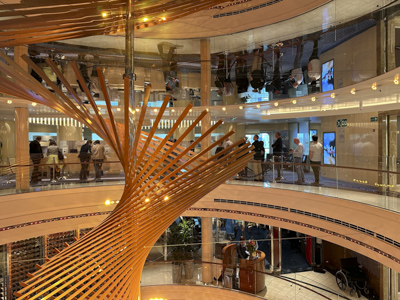

Although the Rotterdam was larger that the last cruise ship we had traveled on, it didn’t feel big and overwhelming. Our favorite place to hang out was the comfortable Crow’s Nest on the 12th level.

We boarded on Saturday afternoon and the ship left Amsterdam that evening. The following day was a “sea day” which gave us plenty of time to explore the ship, settle in, and relax.
Monday May 8th, the Rotterdam arrived in Copenhagen, Denmark.

We got an early start and took the shuttle bus to a Metro station. After a couple of stops on the train, we got off in the center of Copenhagen near Nyhaven. We used Googlemaps and Applemaps to find our way around.
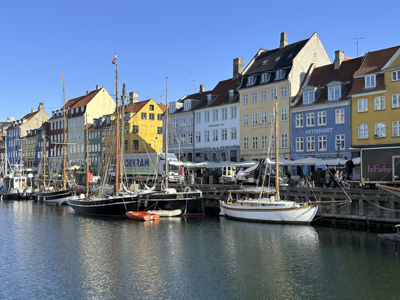
It was a glorious bright sunny morning and we walked along beautiful Nyhaven. Hans Christian Andersen had lived in several houses along the harbor during the early 1800s.

We continued along the main shopping street, Stroget, which is lined with all the familiar international clothing shops, restaurants, and Danish boutiques. We stopped for good coffee along the way.
We saw Christianborg Palace which is the seat of the Danish Parliament and houses the Prime Minister’s Office and the Supreme Court of Denmark. The palace is also used by the queen of Denmark for official events. We had just one day in Copenhagen so we didn’t tour the palace.
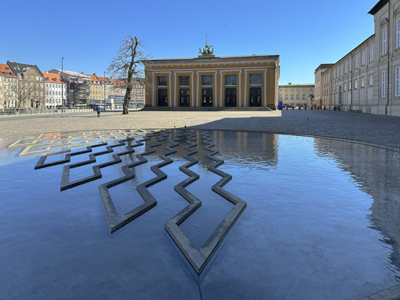
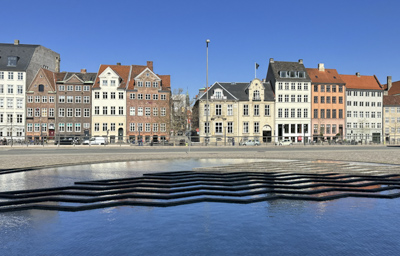
We passed the Ny Carlsberg Glyptotek, one of our favorite museums, and we also saw the entrance to the famous Tivoli Gardens. We had spent a week in Copenhagen on our last visit 21 years ago and visited all these sights, so we didn’t feel the need to visit them again on this trip.
It was getting to be lunch-time, and we were lucky to find Tivolihallen, a Danish restaurant that served delicious “classic open-faced sandwiches” called smorrebrod. It was a family-owned restaurant and the old-fashioned dining room was cozy and comfortable. Of course, they spoke perfect English!

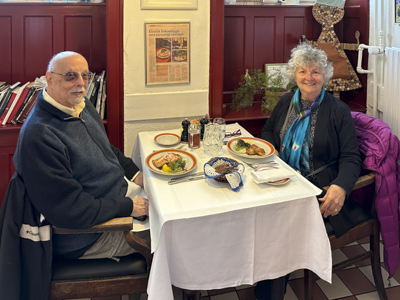
Later we discovered that Tivolihallen is listed in the book: “1001 Restaurants You Must Experience Before You Die.”
After a tasty lunch, we walked toward the Town Hall – Radhus. Although the building was built in 1905, the architecture was inspired by the Renaissance-style Town Hall in Siena, Italy.
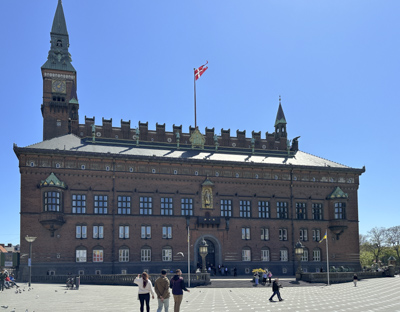
There was a very interesting astronomical clock on display with 15,448 parts. The Radhus is the seat of Copenhagen’s city government so all local city government functions are performed there. They had a table of artificial flowers for rent for their frequent town hall weddings.
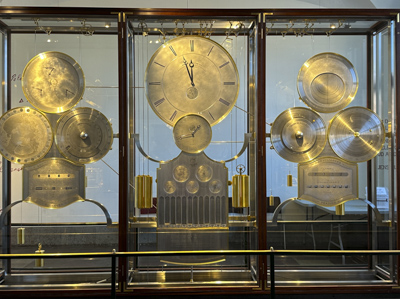
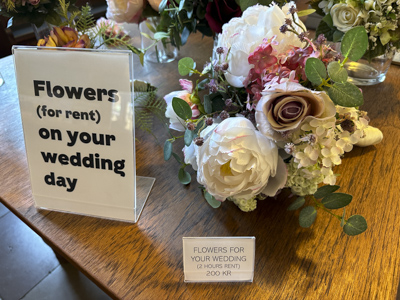
That’s a statue of Hans Christian Andersen near the Radus looking toward Tivoli Garden:
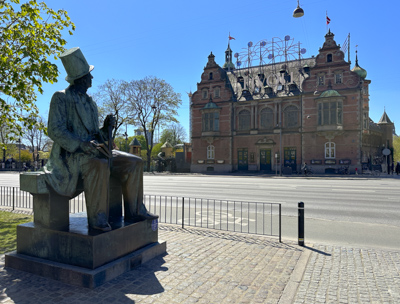
Tuesday May 9 – Warnemunde and Rostock, Germany
Everything we had read at home in preparation for this port said to go to the medieval town of Rostock and not bother with Warnemunde. So we made the trek, and it was a “trek” because we had to take a local commuter train first, then ride the tram to Rostock, then walk into the city center.
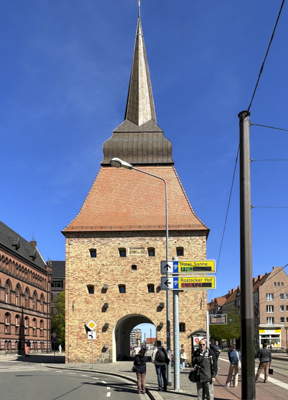
The Steintor, built in 1574, was one of the original gates into the medieval city of Rostock and leads to Neuer Markt which is the historic center. Marienkirche, St. Mary’s Church, was built in 1265.
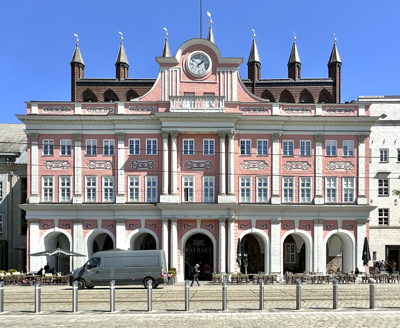
New Market Square (Neuer Markt) features pastel colored merchants’ houses, the pink Town Hall, St. Mary’s Church, and the Rostock Cultural History Museum.

There are bars and restaurants surrounding the square and a daily farmer’s market. It’s a good place to start a tour of the pedestrian streets of the Old Town. We strolled up Kropeliner Strasse, the main shopping street which was full of international brand name stores.


We had a good lunch in a big self-serve cafeteria located on the ground floor of a modern shopping center.


Afterwards, we took the tram to the train and then back to Warnemunde. Because it was still early, we decided to explore the seaside village. We were very happy we did, because we liked Warnemunde better than Rostock! It was a lovely seaside resort town with adorable fishermen’s cottages.

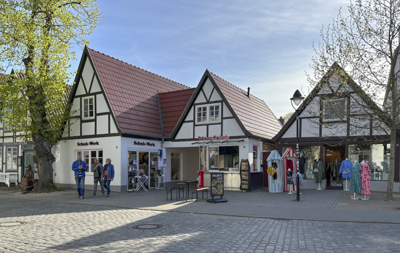
Two famous Warnemunde landmarks are the 19th century lighthouse and the popular Teepott Restaurant located on the seemingly endless beautiful white-sand beach along the Baltic Sea.



Thursday May 11 – Riga, Latvia (Wednesday was a quiet Sea Day aboard the MS Rotterdam)

The ship arrived early in the morning and cruised up the Daugava River and docked near Vansu Bridge across the river from Riga Castle. It was a short walk to the medieval Old Town of Riga, which is a UNESCO World Heritage Site.
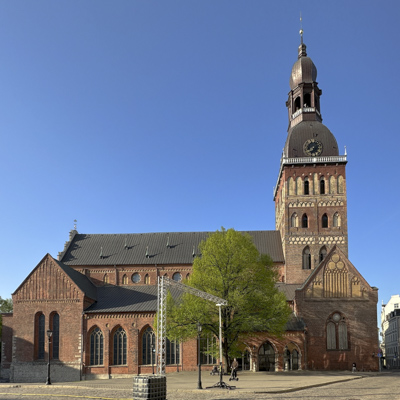
Riga, the capital city of Latvia, was founded in 1201 and had been a member of the Hanseatic League. This was a medieval confederation of market towns and merchant guilds in Northern Europe. The Swedish Gate is all that remains of the Middle Ages fortification wall which once protected the city.

The old town center of Riga, the Vecriga, is a labyrinth of cobblestone streets lined with medieval churches and guild halls. Vecriga today is full of popular restaurants, art galleries, and museums.
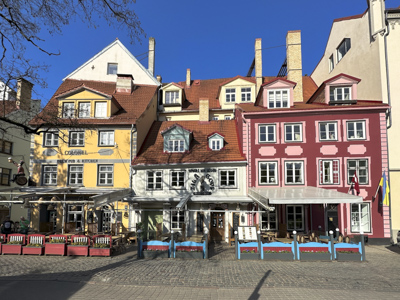

The Central Market is one of the largest and most visited markets in Eastern Europe. The buildings were originally constructed in the late 1920s as German zeppelin hangars. Each one is a speciality market.


The city of Riga is also famous for its more than 800 Art Nouveau buildings constructed between 1901 and 1908. Elizabeth and Albert Streets are outdoor galleries showing off the beautiful architecture.

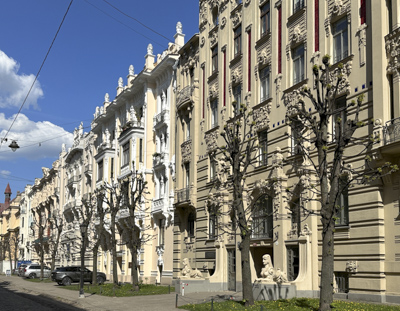
The Powder Tower, built in 1650, is part of the Latvian War Museum and served as a repository of the city’s gunpowder.

Bastejkalna Park runs across both sides of the Pilsetas canal and is home to the Latvian National Opera, the Freedom Monument, and the University of Latvia.

Friday May 12 – Tallinn, Estonia
Calm seas prevailed as the ship left Riga, Latvia and cruised to Tallinn, Estonia. A shuttle bus dropped us off at the Russian Cultural Center near the Viru Gate entrance to the Old Town. Tallinn is listed as a UNESCO World Heritage Site and recognized as one of the best-preserved medieval cities in Europe.
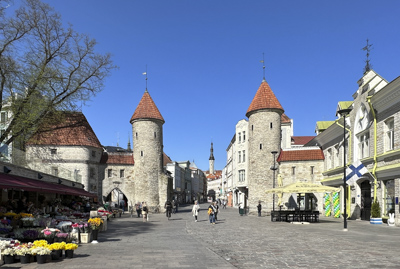
Tallinn grew in importance as the northernmost member of the Hanseatic League during the 14th to 16th centuries. The city was well fortified during the Middle Ages with a large city wall and 66 defensive towers. The wall and many gates are still standing today.

We walked through the Vira Gates along a narrow cobblestone street to Raekoja Plats – the bustling Town Hall Square. Today, the colorful 15th century buildings around the large square house restaurants and other tourist shops. In one corner of the square is the Raeapteek.

Tallinn Town Hall Pharmacy – Raeapteek – is the oldest pharmacy in Europe that has continually operated on the same premises since 1422. An exhibition room displays goods sold at the pharmacy during medieval times including snakeskin potion, mummy juice, powdered unicorn horn, tea, jam, gunpowder, and marzipan. The historic site still operates as a modern pharmacy today.

We had a delightful lunch outdoors at Kaera Jaan Restaurant on Town Hall Square. The restaurant was named after a folklore character and is a popular song.
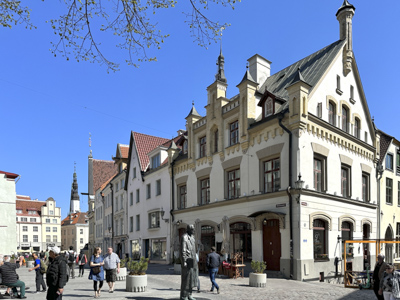
Most of the streets in the Old Town are limited to pedestrians. Tallinn is actually two towns: an upper one and a lower town. Historically, the Upper Town belonged to wealthy aristocrats while the Lower Town housed poor ethnic Estonians.

There are several paths leading up to the Upper Town called Toompea Hill. We climbed steps on our way up, but later found a narrow cobblestone street which led back down to the Lower Town. Alexander Nevsky Cathedral opened in 1900 during the Czarist Empire on top of Toompea Hill.
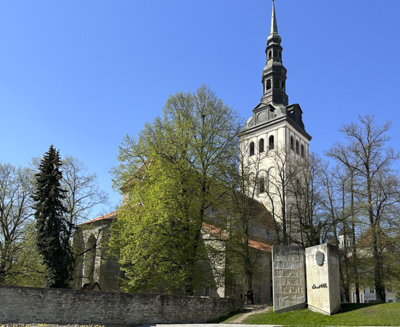
On the way up to Toompea Hill, we passed St Nicholas’ Church which was built from 1230 to 1275. Today, the church functions mainly as a museum of religious art.

Tall Herman Tower was a defensive tower built in 1371 in a corner of Toompea Castle – home to today’s Estonian Parliament. The tower was the highest stone tower around the Baltic Sea during the Middle Ages. Today, Tall Hermann flies the national flag as a symbol of Estonia’s independence.

After visiting the beautiful city of Tallinn, we returned to the ship in the late afternoon. We enjoyed a game of Trivia with Jean and Ed, friends we had met on a previous cruise. Later, we had a delicious dinner in the lovely Rotterdam dining room.
Saturday, May 13 – Helsinki Finland
The distance is 50 miles between Tallinn, Estonia and Helsinki, Finland. During the night, the ship crossed the Baltic Sea and arrived in Helsinki very early in the morning.

It was a ten minute shuttle ride from the ship to the port of Helsinki and the bus let us off near the old indoor market – Vanha Kauppahalli. What a treat! The Old Market Hall was opened in 1889 with 120 stalls and six shops in the central gallery. There were shops selling fish, reindeer soup, elk kebabs, etc.



We strolled along the port and browsed at the outdoor Central Market – Kauppatori. We crossed the street and went to see the exterior of Uspenski Cathedral, the orthodox Church of Finland from 1868.

The grand Senate Square, is lined with impressive landmarks: Helsinki Cathedral, Government Palace with offices of the Prime Minister and the cabinet, and the main building of the University of Helsinki.


The Art Nouveau Central Railway Station – Rautatieasema Jarnvagsstation – was designed by the renowned architect Eliel Saarinen in 1919 and is a monumental landmark in the capital of Finland. The building has been selected as one of the most beautiful railway stations in the world.

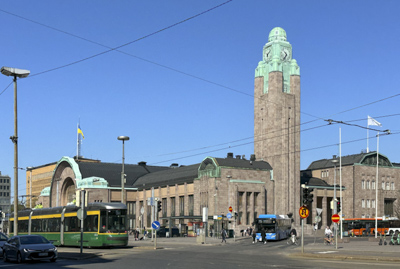
We continued our self-guided walk of Helsinki through the downtown business district.


Before taking the shuttle bus back to the Rotterdam, we strolled through the beautiful green Esplanade Park. Tents were set up with people selling a variety of ethnic foods. Local people were sitting on benches and enjoying the bright sunshine and good weather.

Sunday May 14 & 15 – Stockholm, Sweden
The Rotterdam sailed calmly from Helsinki to Stockholm overnight. The ship was scheduled to be in the lovely port city of Stockholm for two whole days. Wonderful! Stockholm is one of our favorite cities.
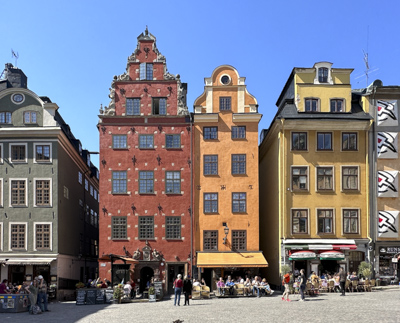
The ship cruised past beautiful pine-tree covered islands as it approached Stockholm harbor. The 20 minute shuttle bus ride into the city dropped us off just outside the historic old district of Gamla Stan.

There was Swedish folk music and dancing in one of the little squares in Gamla Stan when we arrived.
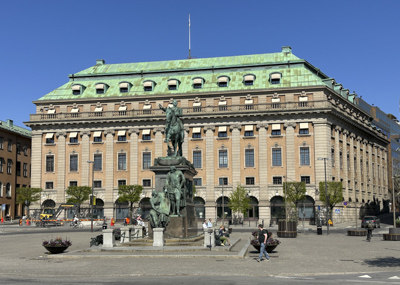

The narrow streets in Gamla Stan are reminders of its medieval roots. We took a cruise around the harbor.

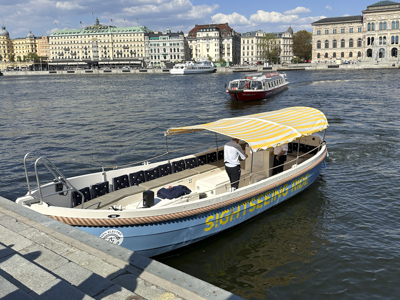

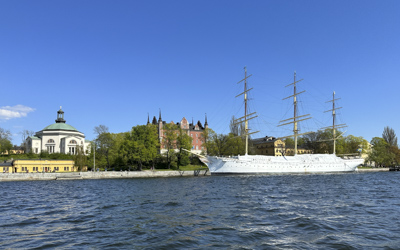
We had a delicious Swedish lunch at a little restaurant called Stockholms Gastabud Bar & Bistro.
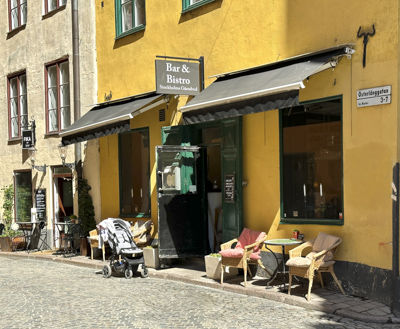

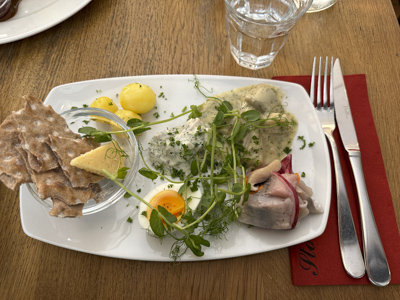
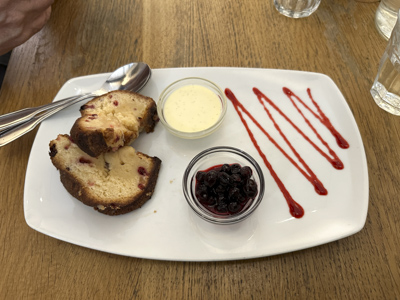
Smoked herring three ways and cranberry cake with linden berries for desert.
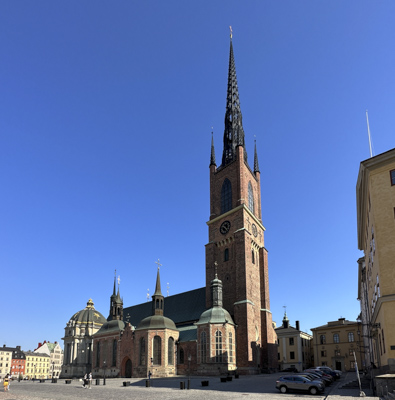
The Riddarholmskyrka, built in the 13th century is one of the oldest churches in Stockholm. The church served as the final resting place of most of the Swedish monarchs until 1950.


I took the photos below in two of Stockholm’s Metro stations. Most of Stockholm’s Metro stations have some sort of art installation and are definitely worth seeing.
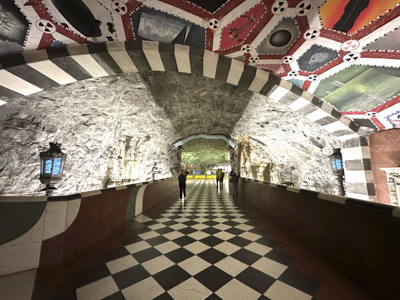

One of the best sights to see is Stockholm’s City Hall and we were lucky to walk in and book a tour. The famous building was built between 1911 to 1923 and houses government offices and conference rooms. The City Hall is famous because the Nobel Prize banquets are held there in the “Blue Hall” every year.




Thursday May 18 – Aarhus, Denmark
We enjoyed a restful Sea Day on Wednesday and arrived in the commercial port of Aarhus early the next day. The shuttle bus dropped us off near the DOKK1 – the modern library which was voted “the best public library in the world” by the International Federation of Library Associations.

Aarhus is the second largest city in Denmark, located on the eastern shore of the Jutland Peninsula. Aarhus was founded in the early Viking Age (8th century) and is one of the oldest cities in the Baltics.

Stroget is the main shopping street but today was a holiday so almost all of the stores were closed. The architecture was a mixture of historic and modern.
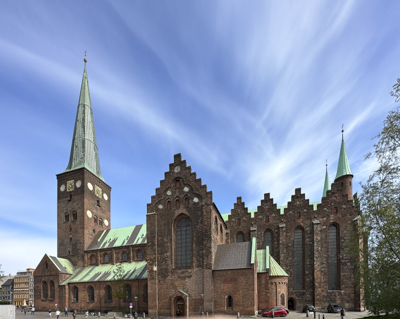
The Cathedral of Aarhus is the longest church in Denmark and has the tallest spire. The church was completed in 1350 and can seat 1200 people. I read that all Danes pay 1% of their income directly to the Danish Church through their tax system. Opting out is an option, however 75% of the people actually contribute.

The Aarhus Art Museum has a collection of Danish and international works of art. The architecture of the building was supposed to be inspired by Dante’s Divine Comedy but the interior reminded me of the the Guggenheim Museum in New York City.

“Your Rainbow Panorama” is a permanent installation mounted on the roof of the museum designed by Olafur Eliasson. It is a circular multi-colored glass walkway. Visitors can walk around inside the structure for magnificent views of the city looking through colorfully tinted glass.

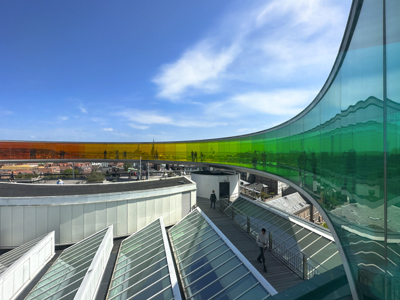
The MS Rotterdam left Aarhus Thursday night and we enjoyed a Sea Day on Friday May 19th. We re-packed and relaxed and enjoyed the ship as we cruised back to Amsterdam.
Saturday May 20: We gave ourselves one more day in Amsterdam. We left the ship and checked into a hotel near Schiphol Airport. From there, we easily took the Metro into Central Station.

Cuyperspassage is the name of a tunnel at Amsterdam Central Station that connects the city with the river. 46,000 traditional blue and white Delftware ceramic tiles were used to decorate the walls.

We were lucky to have another beautiful sunny day to explore Amsterdam. The city was more crowded with tourists this week, but we walked around the Jordan district and enjoyed our last day.



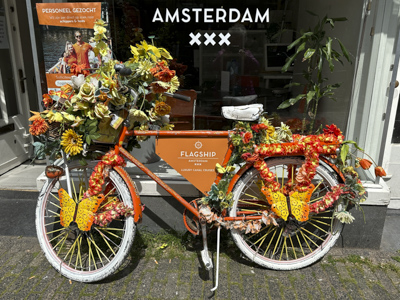
Sunday May 21, 2023 – travel day: Jeff flew home to New York City and I continued my travels to Spain.
